by Ian Skellern
I know that many of you reading this have neither the time, nor the inclination, to wade through hundreds of words of babbling preamble before I ever-so-eventually cut to the chase. So I will sum up our recent participation in the 2017 Passione Engadina vintage car rally as a guest of Jaeger-LeCoultre in just a few bullet-pointed words so you can scan them and continue. I was joined on this adventure by Quill & Pad’s lifestyle guru, Nola Martin.

Blue-dialed Jaeger-LeCoultre Master Ultra Thin Reserve de Marche at the start of the 2017 Passione Engadina rally in St. Moritz

Team Quill & Pad in the 2017 Passione Engadina
Passione Engadina ran over three days out of St. Moritz across the Alps into Bormio, Italy and back, often on small mountain roads with the drives punctuated by short but quite demanding (for us anyway) regularity trials.
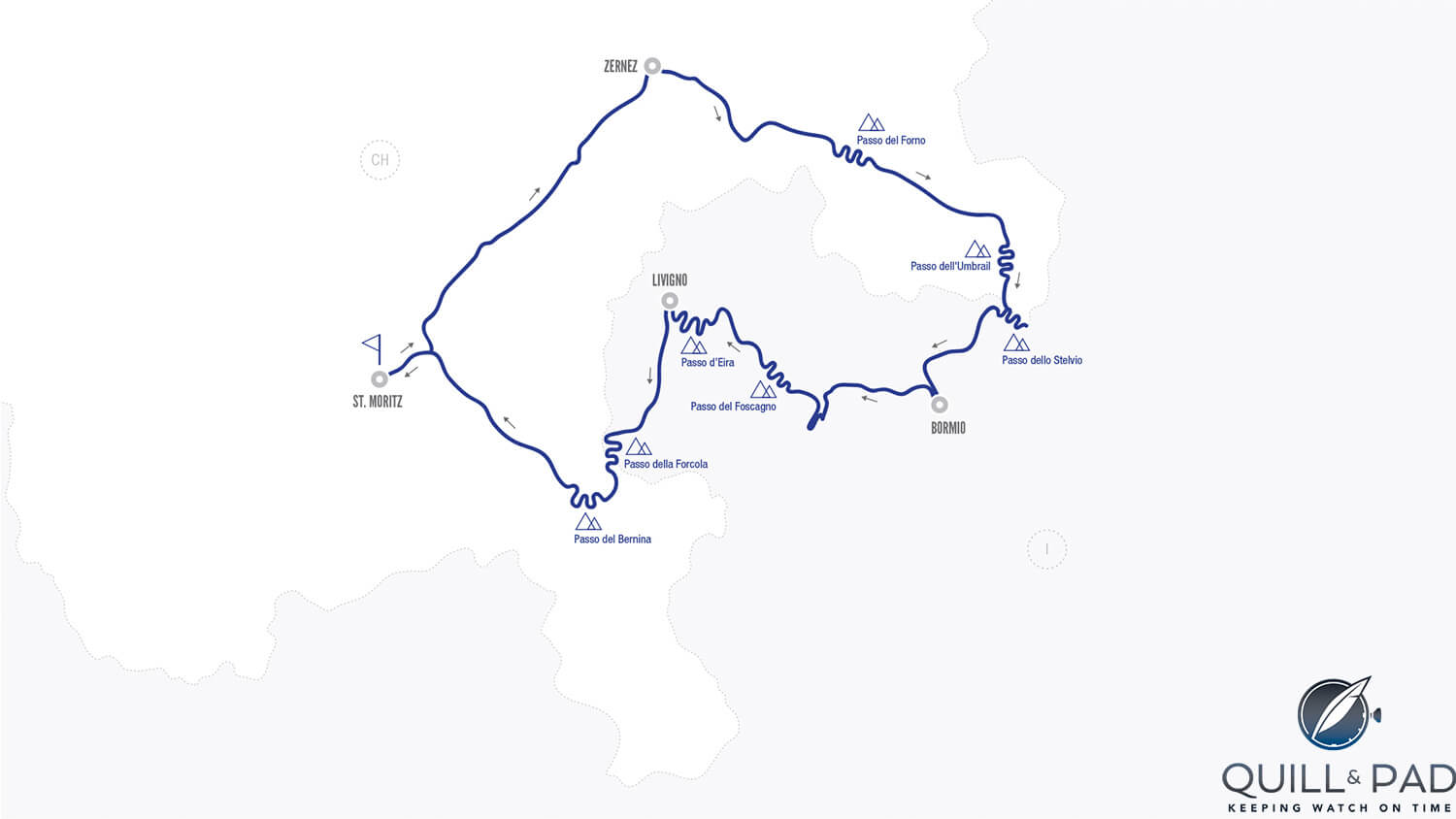
Route of the 2017 Passione Engadina rally in the Alps from St. Moritz, Switzerland to Bormio, Italy and back (the white area is Switzerland, shaded area is Italy)
Oh, and the cars are Italian and manufactured before 1980, that golden era of automotive reliability and quality.

Ian Skellern at the start of the 2017 Passione Engadina rally in St. Moritz
So here is our 2017 Passione Engadina in words you can read in one (big) breath:
- Absolutely breathtakingly stunning scenery
- 1971 Fiat 124 Spider (aka the Pininfarina Spider)
- Beautiful watches
- Blew a water hose at the start of the very first regularity trial
- Torrential rain (did I mention our car was a convertible?)
- Hail
- Leaky roof
- Broken windscreen wipers
- Fogged windscreen
- No de-mister
- Weekend traffic
- Cheering crowds of many millions of well wishers along the route (though fake news reports fewer)
- Truly beautiful vintage cars
- Great backup mechanics
- Incredible range of vintage Ferraris
- Simply fantastic from start to finish!

Ian Skellern and Nola Martin before setting off on the 2017 Passione Engadina rally (our smiles were just as broad at the end)

Jaeger-LeCoultre display at Suvretta House during the 2017 Passione Engadina

Cars on display outside Suvretta House in St. Moritz before the start of the 2017 Passione Engadina
Passione Engadina 2017
By most standards (except perhaps Monaco’s), Switzerland is a relatively small country. But even so it was a five-and-a-half-hour drive from Geneva to St. Moritz, where Quill & Pad teammate Nola Martin and I had been invited by Jaeger-LeCoultre to participate in the Passione Engadina rally, for which the brand was a principal sponsor.
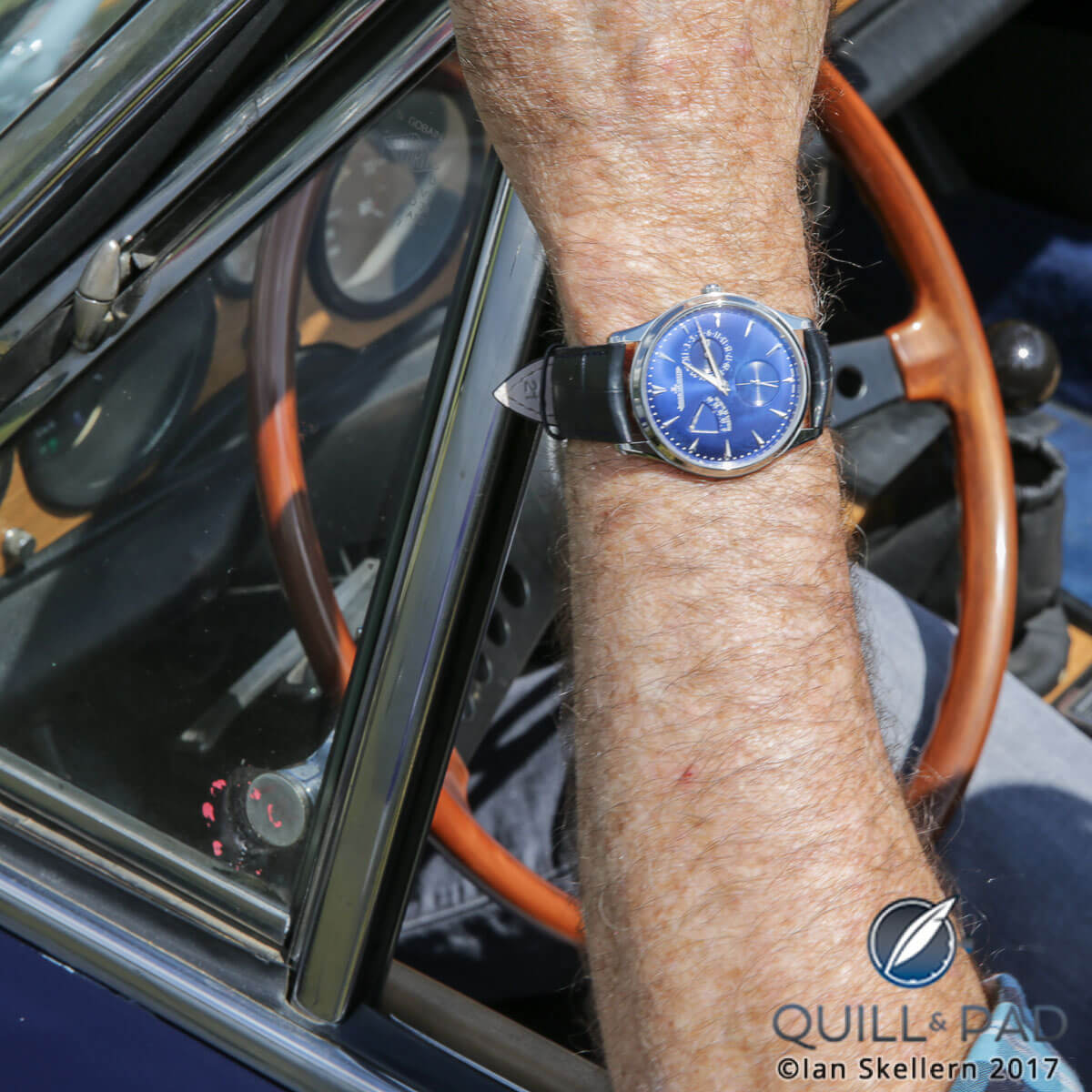
Jaeger-LeCoultre Master Ultra Thin Reserve de Marche on the wrist and ready for action in the 2017 Passione Engadina rally

Driver’s briefing for the 2017 Passione Engadina
After the driver’s briefing on Friday afternoon, we slipped on our loaner watches (I wore a Master Ultra Thin Reserve de Marche and a steel Reverso Duo over the long weekend, while Nola’s wrist tested a steel Master Control Date and a pink gold Reverso Tribute Duoface).
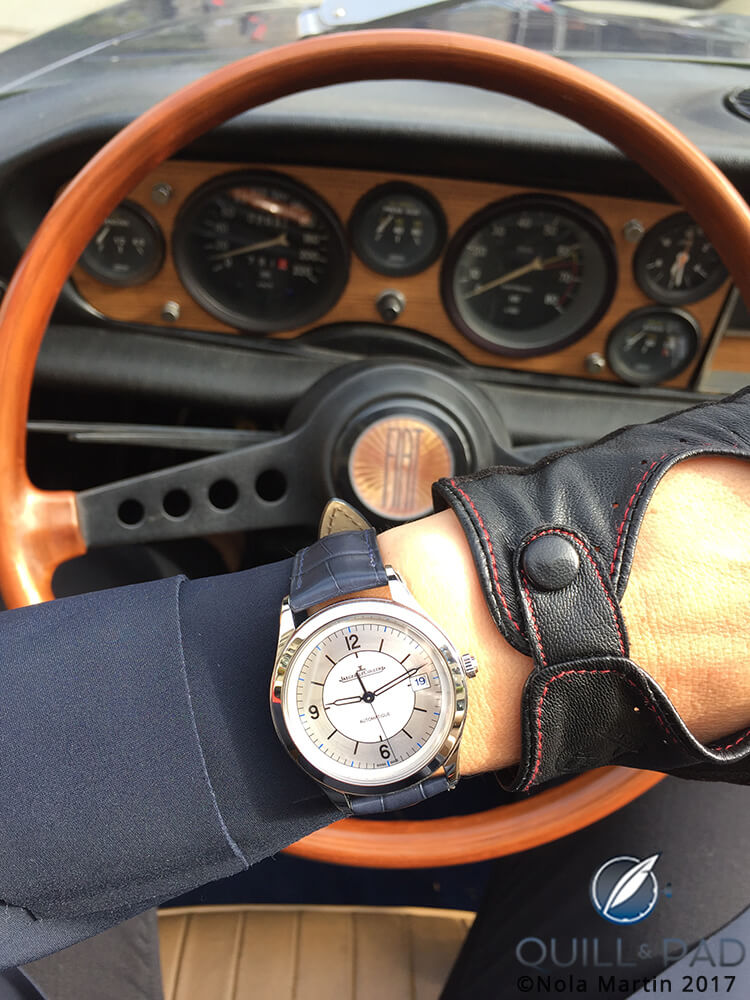
Nola Martin wearing a steel Jaeger Le-Coultre Master Control Date in the 2017 Passione Engadina rally
Those who know me are well aware of my acutely tuned sense of fashion, so will not be surprised at my delight in the deep blue dial of the Master Ultra Thin Reserve de Marche matching the deep blue paintwork of our car. Heaven forbid the colors clashed.
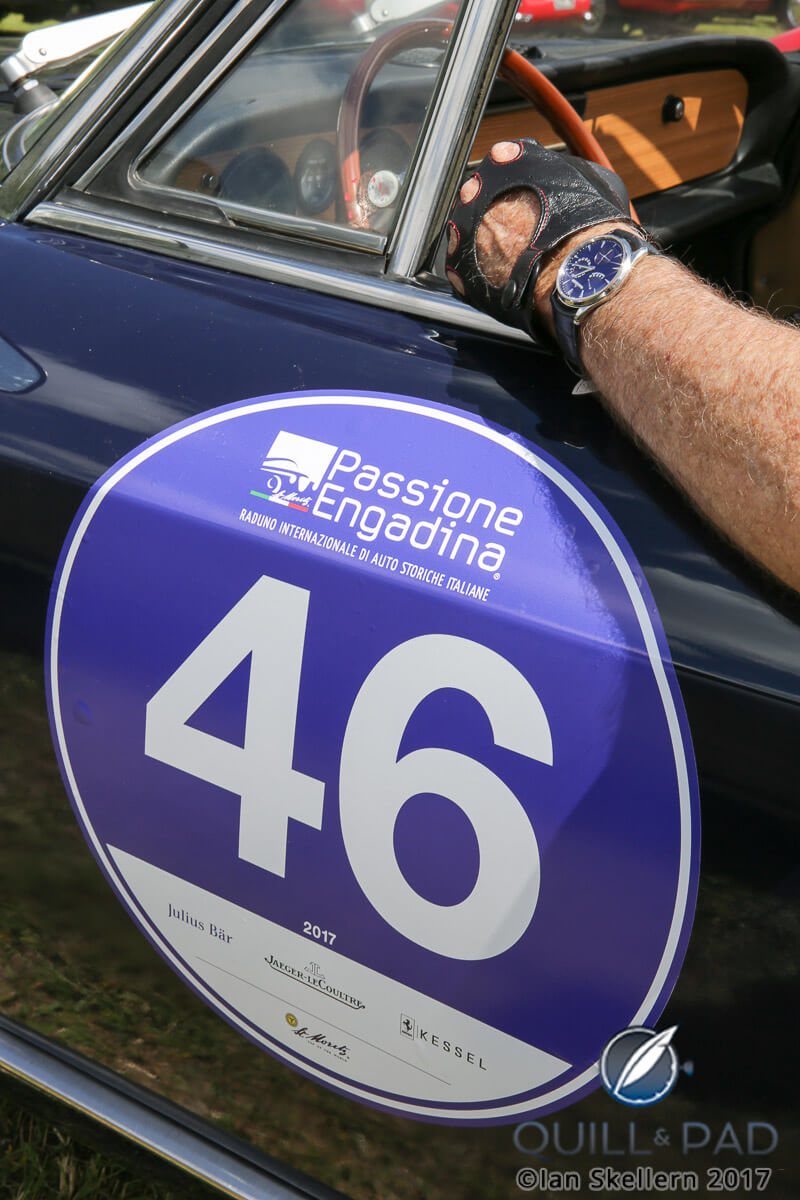
Matching blue hues of the Jaeger-LeCoultre dial, the Passione Engadina sticker, and our Fiat 124 Sport Spider
St. Moritz is an unashamedly upscale town in the Engadin Valley (hence the name of the rally), high in the Swiss Alps near the Italian border. It has hosted two winter Olympics and is well known as a winter playground for royalty, VIPs, and celebrities. However, as Nola and I soon found out, the region was spectacular in summer and the visitors, many biking and trekking, were more casual.

Nola Martin wearing a Jaeger Le-Coultre Reverso Tribute Duoface in pink gold in the 2017 Passione Engadina rally
Nola: The Passione Engadina rally is about classic cars, camaraderie, and chronographs. It is truly a grand event in St. Mortiz, checking every box for an exquisite weekend: five-star accommodations – check; stunning scenery – check; delicious food paired with the perfect wines – check; friendly people – check; and an impressive selection of Jaeger-LeCoultre watches – check. Every detail of the weekend was thoughtfully considered and beautifully planned by a man passionate about cars and life, Paolo Spalluto, the mastermind behind this classic car rally.
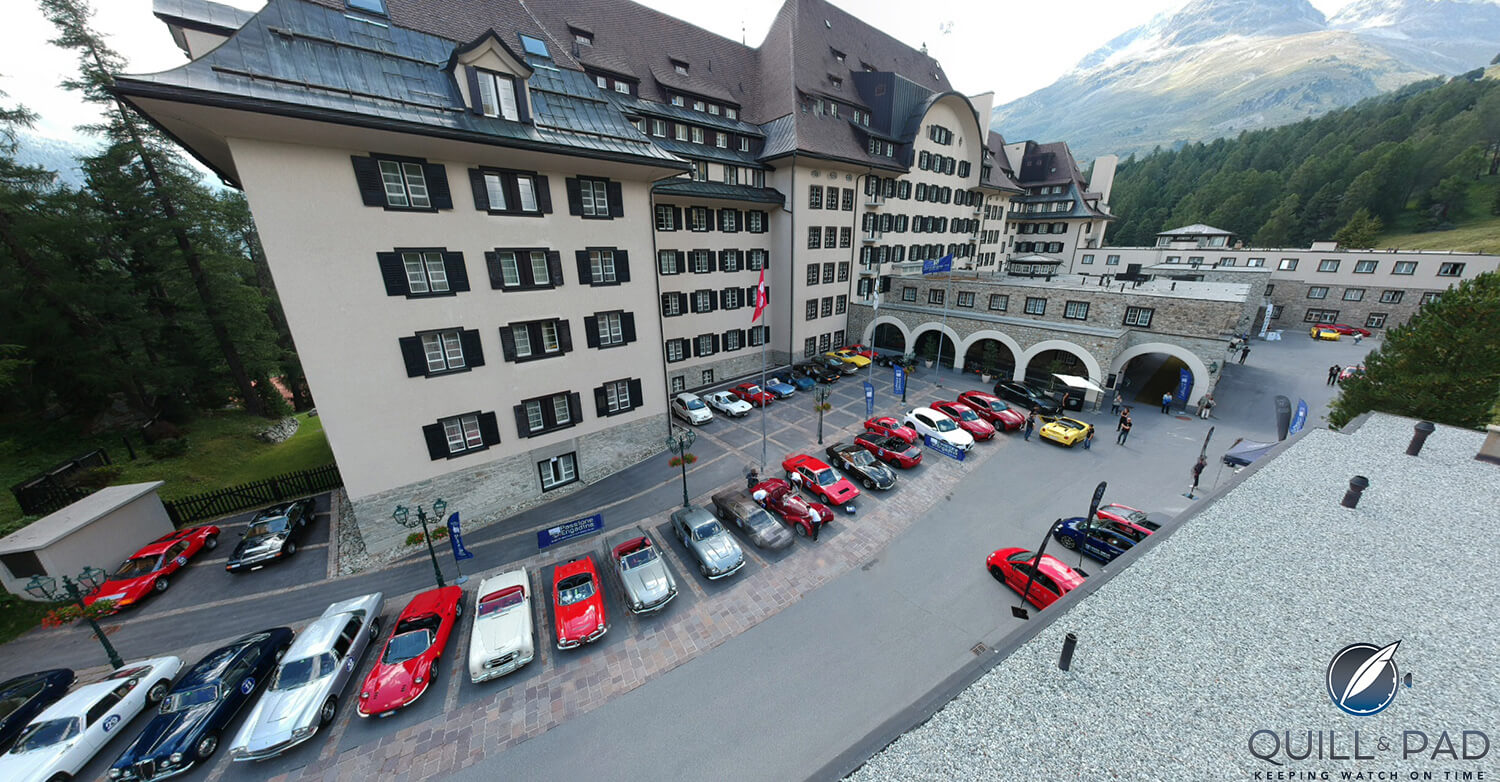
Cars ready at Suvretta House for the 2017 Passione Engadina
Passione Engadina is a regularity rally, also called a time-speed-distance (TSD) rally. The object is to drive each segment of a defined course or route in a specified time at a specified average speed. Regularity rallies are typically driven on public roads and usually include short off-road and track stages (RTs).

Nola Martin at the wheel wearing a Jaeger-LeCoultre Master Control Date
Day 1 (Friday afternoon): the Kessel Challenge Cup part 1
On arriving at our hotel, St. Moritz’s majestic, though understatedly named, Suvretta House, we learned this was where the rally proper would be starting the next morning. Around noon on Friday the adventure began after Nola and I successively had a brief introduction to our car for the race, lunch, and the driver’s briefing, finally heading out with a frisson of anticipation to a military airport around a 30-minute drive away for the Kessel Challenge Cup, first of the regularity trials. These usually took just a few minutes at most and had timing sensors throughout checking average speeds to 0.01 of a second.

Queued at the start of the Kessel Challenge Cup part 1
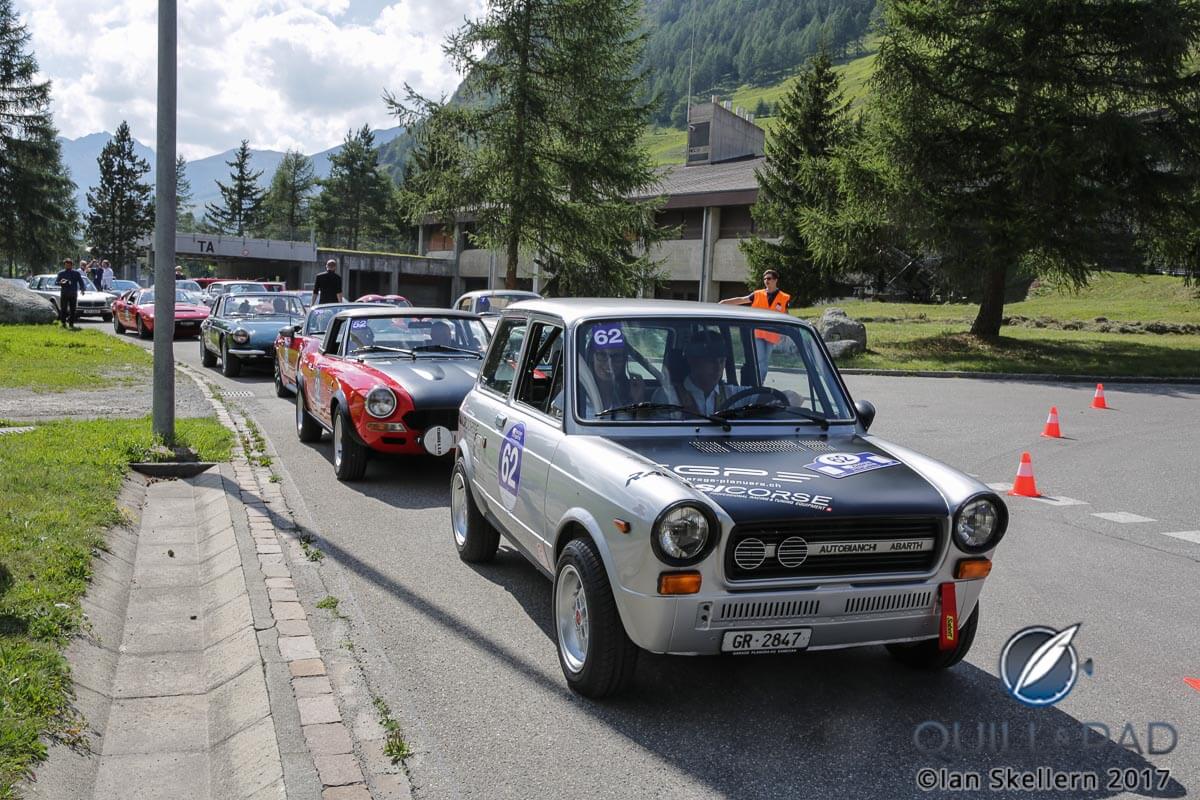
Lining up at the start of the Kessel Challenge Cup part 1
Experienced drivers confirmed before the trials whether the sensors were optical or pneumatic, as the former were triggered by the passing of the front of the car, while the latter were activated by the wheels passing over, and that had to be factored in.

Lining up at the start of the Kessel Challenge Cup part 1
As we queued for the start of the trial, without the cooling effect of driving at speed our car’s engine temperature began to rise. Normally we would have stopped the engine, but we were worried that we were soon to set off and that the unfamiliar hot engine might not start on demand. And everything went well until a couple of minutes before our start when a cabin water heater hose started leaking, sending a high-pressure jet of scalding water into the cabin, steaming and spraying the inside of the windscreen.
However, the hose had only split, not burst, and while the geyser was visually impressive, it was not losing a lot of water. Having air moving through the radiator was likely to drop the engine temperature. Nola jumped out to avoid the risk of burns had the hose burst and with little visibility, no timing equipment or route map (too wet), and the possibility of being scalded, I drove across the start in a cloud of steam and completed the course.

1956 Fiat 8V in the 2017 Passione Engadina

Blue and green should never be seen unless one is a grassy hill and the other a 1978 Ferrari 308 GTS in the 2017 Passione Engadina
Nola: It’s not about speed – that is for sure. We started out the race with a friendly, competitive spirit that quickly disappeared after our first regularity test when the car started to overheat and then at the starting line the engine would not turn over. Steam was pouring out of the hood, and hot water began spraying out on the passenger side! It escalated quickly to the point that I jumped out. I can’t believe you actually drove the first regularity test solo! That was definitely memorable.
We had completed our first event, our on-call mechanics refilled the radiator, the car was working well, and we knew what we were doing. Well, so we thought for a short while at least.

Jaeger-LeCoultre Master Control Chronograph in the 2017 Passione Engadina
1971 Fiat 124 Sport Spider 1,600
Though it had its idiosyncrasies, which we came to love, our little 1971 Fiat 124 Sport Spider came with some serious street cred: its body was designed by Pininfarina and its four-cylinder twin cam engine was developed for Fiat by ex-Ferrari engineer Aurelio Lampredi.

1971 Fiat 124 Sport Spider in the 2017 Passione Engadina rally
The 1.592 cc engine developed a let’s call it sufficient 108 hp at 6,000 revs and you needed to keep the revs up to have any power. But the benefit of that is that with a fairly unrestricted muffler, the little motor roared, sounding to our ears like a supercar, especially through the mountain tunnels – of which there were many.

1971 Fiat 124 Sport Spider in the 2017 Passione Engadina rally
But given our experience, the conditions, and the fairly rudimentary suspension (front with wishbones and coil over damper, coil-sprung live rear axle), we didn’t need more power. And this sporty little coupé was also known for its folding convertible roof, which could easily be raised or lowered in less than a minute, a feature for which we were very grateful.

1971 Fiat 124 Sport Spider in the 2017 Passione Engadina rally
Day 2 (Saturday): the Julius Baer Rally part 1 (St. Moritz – Bormio)
For the week leading up to this event, rain had been predicted for most of the day Saturday, which is less than ideal when driving relatively old cars without proper – if any – roofs. But over the 24 hours leading up to the rally, the forecast changed to dry all day and we worked up to brilliant sunshine.

1965 Fiat 8V 1954 in the 2017 Passione Engadina
What a glorious day to be driving through beautiful alpine scenery en route to Bormio and back, including lunch in the mountains on the Italian side. It really doesn’t get much better than that!

The car at the bottom of this image highlights the scale of the mountain passes in the 2017 Passione Engadina
We set off (Nola and I were alternating the driving and navigation) with the cars leaving in one-minute intervals and were soon climbing and descending high passes on secondary roads. The roaring exhaust of the open-topped little sports car was intoxicating, the roads demanding, and the mountains and valleys just breathtaking. And we slowly started to decipher the myriad unfamiliar terms and icons in the road book – the rally bible – which was basically a paper-based analogue GPS that demanded constant concentration.
Nola: The route for the rally was stunning . . . driving the around the curvy roads through the Bernina pass while taking in panoramic Alpine views was breathtaking. The echoing sounds from Italian autos such as a Ferrari Dino 308 GT 4 and a Maserati 3500 GT only added to the splendor of the scenic views of the Alps and picturesque valleys. It was just as exciting to see the glacier tuck into the mountains as a Lancia sped past.

Straight out of “Mad Max”: a 1977 Lancia Stratos in the 2017 Passion Engadina
The driving was interesting and fun, navigating was challenging work, and it was easy − well, we found it relatively easy − to lose the way. Or just as bad, to lose confidence while you were still on course.

Deciphering the rally road book is an essential art
Nola: Seriously, the road book is as thick as a textbook, detailing every sign, right, left, and roundabout on the route and every meter of the rally. It is worlds apart from using Google Maps! The driver and co-pilot are equally important, however: the job of the co-pilot is tremendously important as he or she might have to be a bit of a math wiz to be successful. Once we managed to sort out road book, we put the top down, hit the gas in our Fiat 124 Spider, and headed for the mountains.

Just a few of the cars in the 2017 Passione Engadina
Nola and I completed the occasional RTs (short timing trials) that peppered the day with ever increasing, but entirely misplaced, confidence and pulled into our scenic lunch stop in Bormio on a high. This was fun and we (naively) felt we were doing well (a top 50 percent finish would be nice).
Nola: Let’s talk about the lineup of exceptional cars. A standout moment for me was hearing the yellow Ferrari 275 GTB 4 from 1966 start its engine at the beginning of the rally and seeing the Alfa Romeo 6c 2500 SS from 1939 cruising through St. Moritz, which felt like a time warp.

Nola Martin and Ian Skellern wearing Jaeger-LeCoultre Reversos at a dinner event during the 2017 Passione Engadina
Day 2 (Saturday): the Julius Baer Rally part 2 (Bormio – St. Moritz)
As we waited for dessert at the restaurant, the rain came. It wasn’t that heavy and, as it was only showering lightly when we exited after lunch, we left the roof down. That turned out to be a mistake. The road descended the steep mountain pass and was a continuous series of sharp hairpin curves. The rain started to fall in ever heavier amounts and was painful when drops hit the eye as they did regularly. Then it started hailing. We needed to put the roof up, but there were few places to pull over on this sinuous road; the extremely poor visibility meant stopping was too dangerous.
But we soldiered on (well, Nola did) using “Spidey sense” rather than vision, managing to pull off so we could pull up our roof. After being fully exposed to the elements and feeling wet and cold (we were also well over 1,000 meters above sea level), we were now dry and snug setting off with a cover over our heads.
Heaven. Until . . .
It was a real gale outside with the wind and rain coming horizontally. Which meant we had to wind our windows up – which immediately led to the inside of the windscreen fogging up. And that alone would have been enough, but then in full gale with thunder and lightning all around, the wipers stopped working. So now we had poor visibility on both sides of the windscreen, which, while stressful, somehow only added to the adventure.

The weather closes in with rain and hail at the 2017 Passione Engadina
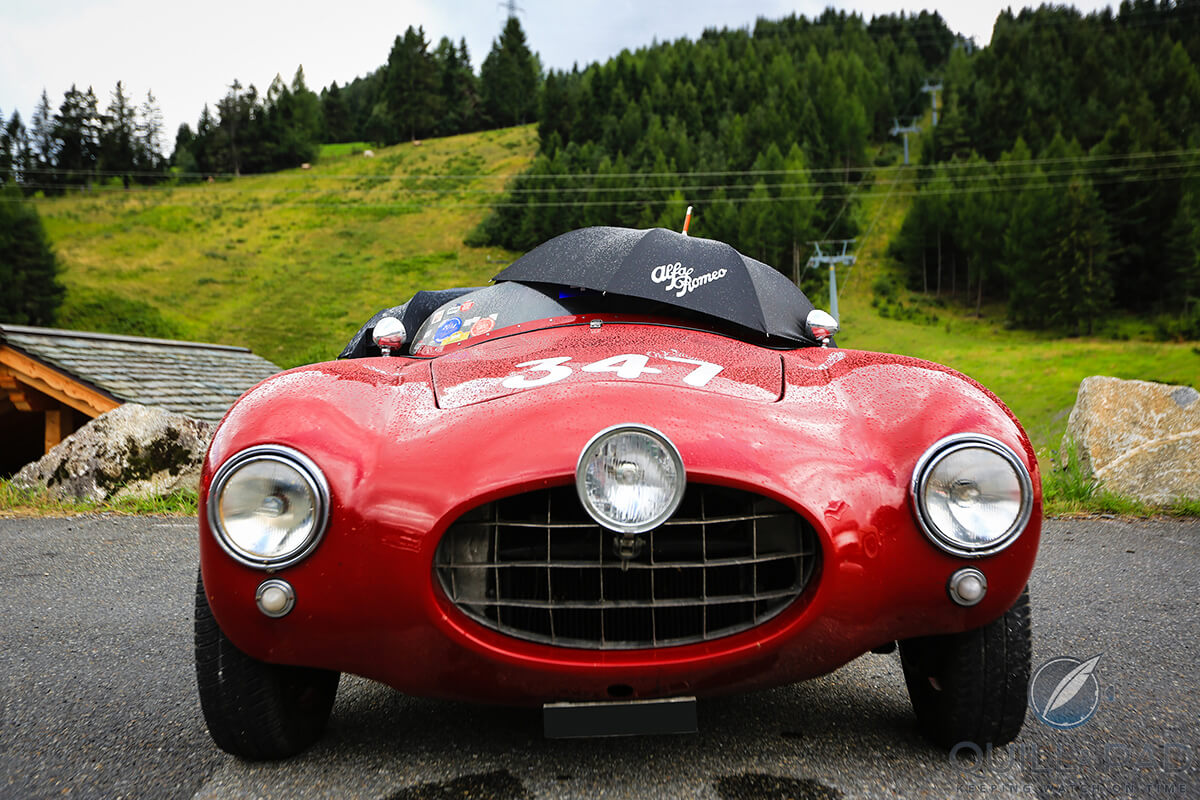
This 1952 Fiat Ermini 1100 Sport shelters under an umbrella in the 2017 Passione Engadina

1985 Fiat 124 Spider Volumex driving through inclement weather during the 2017 Passione Engadina
Nola: Although the Engadin landscape is impressive, it turned rough when it started to hail and the top was down. Arghhh! We quickly pulled over and latched on the roof only to incur steamy windows and broken wipers while cautiously driving switchbacks down a mountain. The technical complications and the challenging weather certainly increased the level of difficulty, but added another element of excitement.

1962 Fiat 2300 Coupé 6 Cylinder in the 2017 Passione Engadina; and, yes, that’s a glacier in the background
Then, the storm passed, the skies cleared, and we arrived safely back in St. Moritz to reminisce on an excellent day of adventures and experiences, though perhaps slightly less excellent for those in cars with no roof at all.

Team Quill & Pad (Nola Martin and Ian Skellern) finish the Passione Egadina 2017 to the adulation of a crowd of millions (at least!)

Just a few of the nicely shaped rear ends at the 2017 Passione Engadina

Nola Martin found the Jaeger Le-Coultre Reverso Tribute Duoface in pink gold to be the perfect watch for the 2017 Passione Engadina rally
Nola: The perfect accessory to our classic car was our classic Jaeger-LeCoultre watches! It was so fitting to wear the Jaeger-LeCoultre Reverso Tribute Duoface in pink gold, a pleasure to wear and ideal for the occasion – or any occasion, really. The silver-toned face was perfect for day wear for me, and then once I slipped into my gala attire I simply switched to the sophisticated dark dial for a fabulous evening at the Kulm Hotel.

After the 2017 Passione Engadina with our Fiat 124 Sport Spider on the right
Day 3 (Sunday): the Kessel Challenge Cup part 2
Sunday morning started with part 2 of Kessel Challenge Cup RT (regularity trial), as we had done part 1 on our first afternoon. Nola and I knew that this trial was at the airport about 30 minutes away. Because we had done the route before, we did our best to follow the directions in the road book. Which caused us a few hiccups until we realized that this trial would be at a different airport than the first.
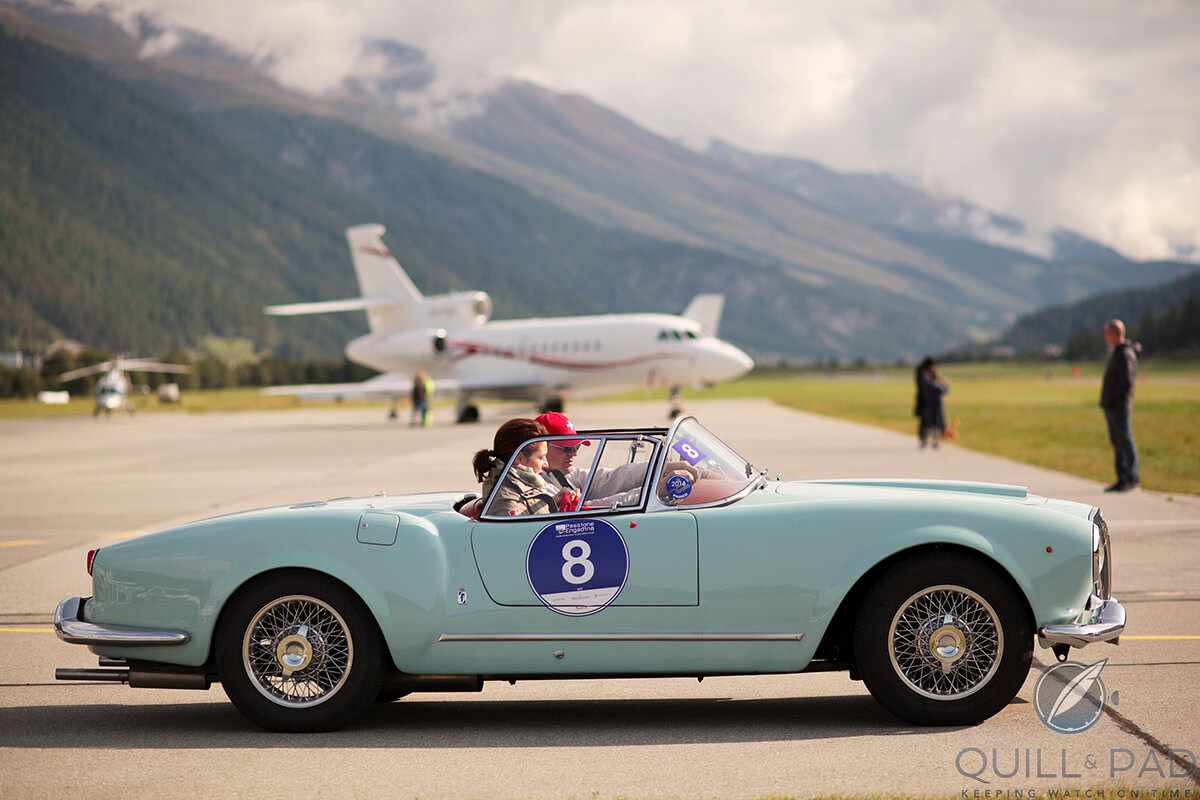
Engadina airport for the final challenge in the 2017 Passione Engadina with a very pretty 1975 Lancia Aurelia B24 S Spider America in the foreground
This final timing trial was straightforward as far as its route was concerned, but a challenge to time due to the sheer number of intermittent stages throughout.

At the Engadina airport in St. Moritz on Sunday morning for the last trial in the 2017 Passione Engadina
Nola: RTs are perfect events to sport your chronograph (though the pros time to 1/100 of a second) as it is a regularity race. It takes loads of self-control to not speed through them. Imagine being on an open runway with a straightaway stretching out in front of you and you can’t floor the gas pedal! To be successful at the regularity test you must maintain the average speeds, which happen to be around 25 kilometers per hour. It was an enjoyable challenge.
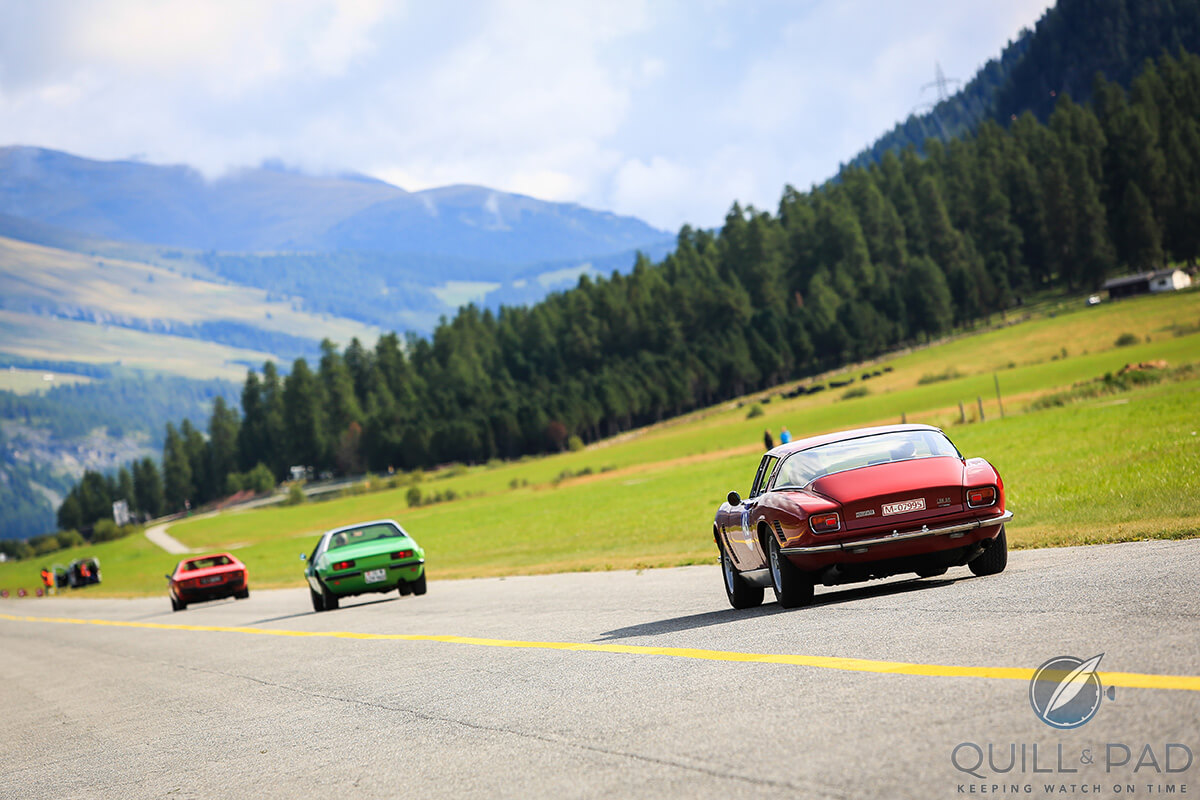
This is the caliber of cars we were up against in the final stage of the 2017 Passione Engadina

Car 46, Team Quill & Pad, either waving or using highly sophisticated hand-air deflection to assist braking in the last regulation trial of the 2017 Passione Engadina

Concours d’Elégence Luigino Della Santa 2017 at the Kulm Hotel in St. Moritz
We passed, though not with flying colors, and then on to the regal Kulm Hotel in St. Moritz for the Concours d’Elégence Luigino Della Santa.

Concours d’Elégence Luigino Della Santa 2017 at the Kulm Hotel in St. Moritz
Nola: Even with one rally under my belt (see my rookie experience with Elizabeth in Richard Mille’s 2016 Princess Rally: The Ultimate Road Trip), there is still a lot to learn. Ian, thanks for coaching me through and elevating my driving abilities. By the end of the rally I finally nailed turning corners!

Concours d’Elégence Luigino Della Santa 2017 at the Kulm Hotel in St. Moritz

Concours d’Elégence Luigino Della Santa 2017 at the Kulm Hotel in St. Moritz
Ottaviano and Matteo Checchi won both the 2017 Passione Engadina rally and the Kessel Challenge Cup in their beautifully presented 1970 Maserati Indy.
Nola: 2017 marks the first year of Jaeger-LeCoultre’s partnership with Passione Engadina, and the two are lined up for a successful future together. I anticipate new timepieces coming soon for Jaeger-LeCoultre that pair closely with the vintage car atmosphere.

Jaeger Le-Coultre Reverso Duo in steel in the 2017 Passione Engadina rally
Nola and I would like to thank the organizers of Passione Engadina for hosting a very enjoyable event and to Jaeger-LaCoultre for the opportunity to participate.
For more information, please visit www.passione-engadina.ch and www.jaeger-lecoultre.com.
Quick Facts Jaeger-LeCoultre Master Ultra Thin Reserve de Marche
Case: 39 x 9.9 mm, stainless steel, water resistance 50 meters
Movement: automatic JLC Caliber 938
Functions: hours, minutes, seconds; power reserve indicator
Quick Facts Jaeger-LeCoultre Reverso Tribute Duoface
Case: 42.9 x 24.5 x 9.4 mm, pink gold, water resistance 30 meters
Movement: manually wound JLC caliber 854A/2
Functions: front dial: hours, minutes, seconds; back dial: second time zone and 24-hour display
Quick Facts Jaeger-LeCoultre Master Control Date
Case: 39 x 8.5 mm, stainless steel
Movement: automatic JLC Caliber 899/1
Functions: hours, minutes, seconds; date
Price: $5,700
You may also enjoy Richard Mille’s 2016 Princess Rally: The Ultimate Road Trip.





















































Leave a Reply
Want to join the discussion?Feel free to contribute!